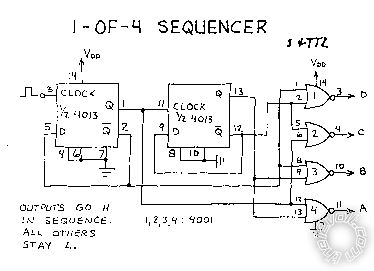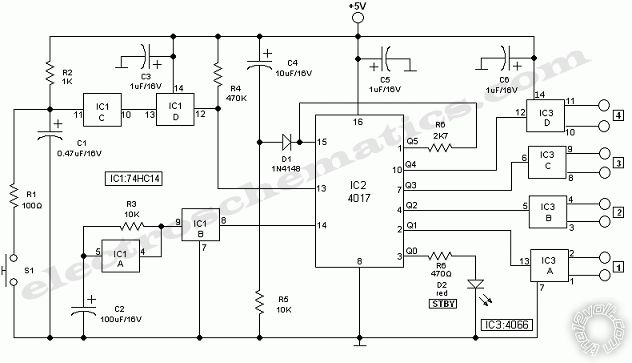flip flop circuit with constant switch
Printed From: the12volt.com
Forum Name: Relays
Forum Discription: Relay Diagrams, SPDT Relays, SPST Relays, DPDT Relays, Latching Relays, etc.
URL: https://www.the12volt.com/installbay/forum_posts.asp?tid=138959
Printed Date: January 01, 2026 at 8:15 PM
Topic: flip flop circuit with constant switch
Posted By: shifto
Subject: flip flop circuit with constant switch
Date Posted: May 12, 2015 at 1:02 AM
I'm trying to figure out how to switch between two inputs with a single constant switch rather than a momentary. All of the flip flop relay circuits I have found use a momentary switch.
I'd like to use the power switch on a radio for this. Turn on and input 1 is selected, turn off, then turn on again and input 2 is selected.
The only thing I can think of is to use a circuit to "convert" the constant switch to give a momentary output and use that to trigger the flip flop circuit.
Any thoughts would be appreciated!
Replies:
Posted By: davep.
Date Posted: May 12, 2015 at 3:18 PM
shifto wrote:
I'm trying to figure out how to switch between two inputs with a single constant switch rather than a momentary. All of the flip flop relay circuits I have found use a momentary switch.
I've thought about this question for a day. The answer is "the control doesn't matter if the switch is constant or momentary". The constant-on switch is like holding the button down indefinitely. It won't hurt anything, and turning the switch off is the same as finally lifting your finger off the button.
Look at this diagram. You will have to change terminal 85 on the far right, and far left relays to GND, so it will respond to a (+) trigger at the switch/button.

When the power comes on, it will turn the latch on.
When the power goes off, the trigger relays (far left, and 3rd from left relay) will change state.
Power on again, latch turns off.
Power off, trigger (right 2 relays, purple) changes state.
Rinse and repeat.
Connect the output of the array (blue) to as many double-throw relay coils as you need to do the switching you require. The N.O. contacts in these relays will be the array ON, and the N.C contacts will be the array OFF.
I offer one caution. You must connect the "Constant 12V supply (red) to an IGN or ACCY source because if the array is ON when you shut the IGN off, the array will stay energized until the battery goes dead. With 3 coils energized, the draw is significant. When you do this, the initial power-up of the radio will always result in the array turning ON. so make the N.O. contacts of your switcher relays the priority.
This should get you going.
Posted By: hotwaterwizard
Date Posted: May 12, 2015 at 10:03 PM
NICE ONE LET ME THINK ABOUT IT
-------------
John DeRosa (Hotwaterwizard)
Stockton California
When in doubt, try it out !
Posted By: shifto
Date Posted: May 12, 2015 at 10:12 PM
Interesting thought that the control does not matter. I guess I was hoping for a solution that would not leave the relays energized the whole time.
It does have me thinking about using latching relays to simplify things.
I'm also thinking about some sort of sequential circuit that could switch between 3 inputs.
To take a step back, I'm wondering how the power switch on the radio could be used to switch inputs each time it is powered on and off.
Thanks for your input!
Posted By: hotwaterwizard
Date Posted: May 12, 2015 at 10:26 PM

------------- John DeRosa (Hotwaterwizard)
Stockton California
When in doubt, try it out !
Posted By: hotwaterwizard
Date Posted: May 12, 2015 at 10:28 PM
Every time power is switched on and off the circuit switches to a different input. just add a switch to turn the circuit on and off.
-------------
John DeRosa (Hotwaterwizard)
Stockton California
When in doubt, try it out !
Posted By: hotwaterwizard
Date Posted: May 12, 2015 at 10:41 PM
 ------------- John DeRosa (Hotwaterwizard)
Stockton California
When in doubt, try it out !
Posted By: howie ll
Date Posted: May 13, 2015 at 6:26 AM
Is this relevant? Back in the day Rolls Royce OEM and myself for aftermarket installs did the following.
You had a radio and an 8 track or cassette.
Both are powered and when the radio is switched on the remote antenna feed (or tap it's on/off) then switched an 8 pole changeover relay for the speakers.
I also did that for a home combi 20 years ago, Sony Profeel with it's own speakers, turned on the Yamaha amp and the outputs switched to "proper" speakers.
-------------
Amateurs assume, don't test and have problems; pros test first. I am not a free install service.
Read the installation manual, do a search here or online for your vehicle wiring before posting.
Posted By: hotwaterwizard
Date Posted: May 13, 2015 at 7:59 PM
YES YES YES I remember those.They use to sell a box at Radio Shack for the CB that used the Car Speakers when the CB was on.
-------------
John DeRosa (Hotwaterwizard)
Stockton California
When in doubt, try it out !
Posted By: howie ll
Date Posted: May 13, 2015 at 11:39 PM
Are you as old as me then?
In those days it was 4 pole relays plus the double gang front back fader pot!
RR used to mount them on a lovely PCB under the radio with a common ground on the (-) speaker side.
-------------
Amateurs assume, don't test and have problems; pros test first. I am not a free install service.
Read the installation manual, do a search here or online for your vehicle wiring before posting.
Posted By: hotwaterwizard
Date Posted: May 13, 2015 at 11:49 PM
Well my birth day is the 21st of this month. I"ll be 54
My Dad started me out wit Vacuum Tube TV's
-------------
John DeRosa (Hotwaterwizard)
Stockton California
When in doubt, try it out !
Posted By: howie ll
Date Posted: May 13, 2015 at 11:51 PM
Still a youngster then, 68 in September and starting to feel it.  ------------- Amateurs assume, don't test and have problems; pros test first. I am not a free install service.
Read the installation manual, do a search here or online for your vehicle wiring before posting.
|



